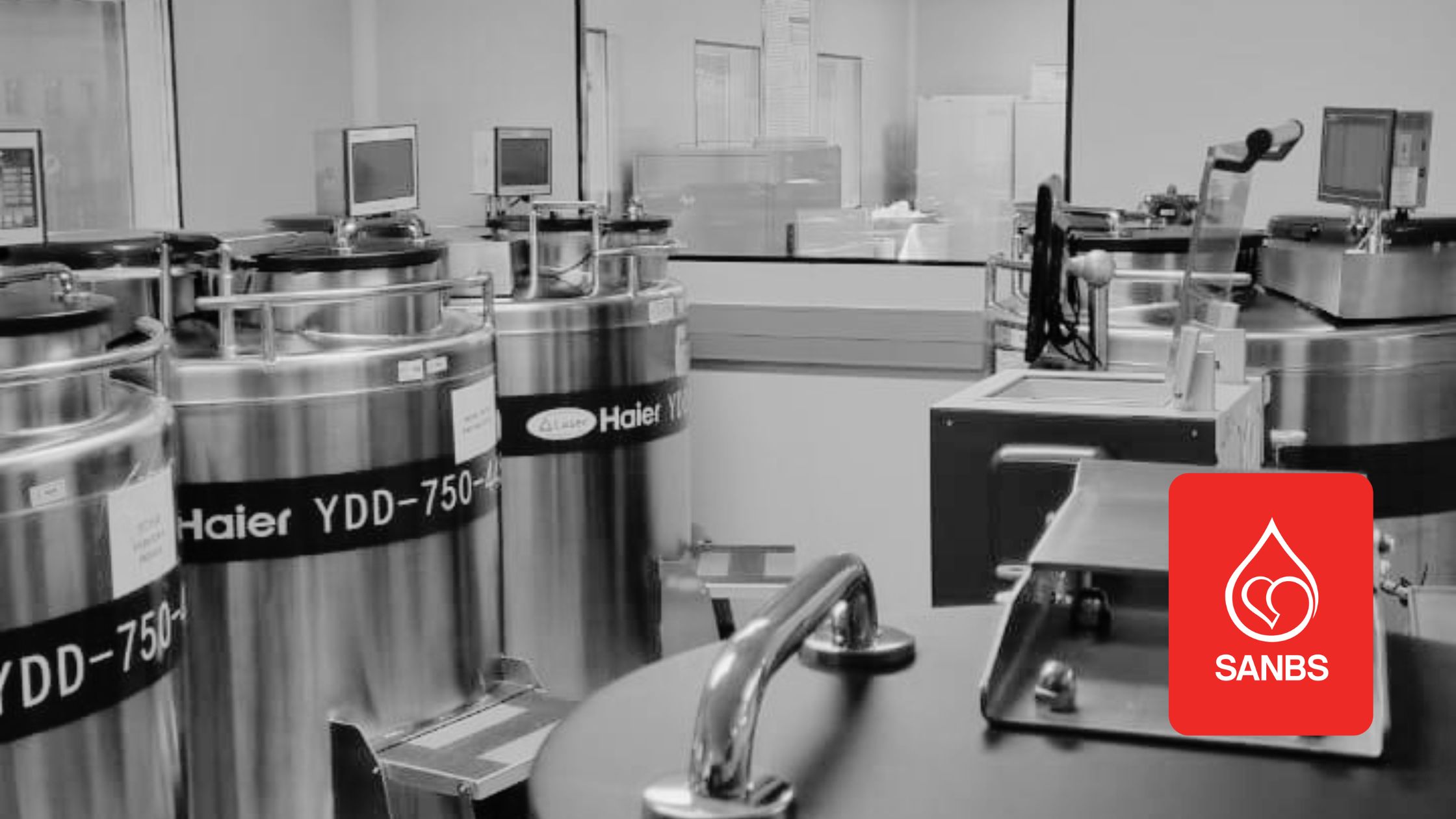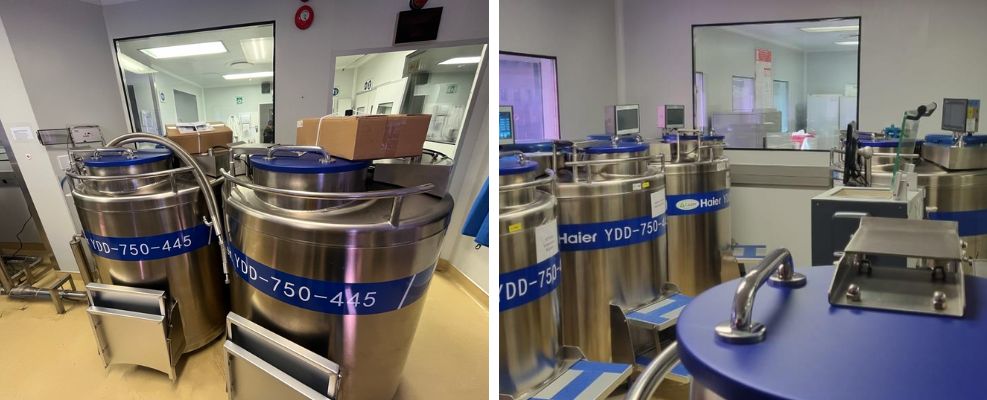Enhancing Biological Sample Storage with Lasec®: A Case Study of SANBS

Reliable storage solutions are essential for long-term biological sample preservation in healthcare, ensuring vital resources remain viable for diagnostics, therapies, and future studies. The South African National Blood Service (SANBS) partnered with Lasec® to upgrade its liquid nitrogen (LN2) storage system. This collaboration not only addressed SANBS’s growing storage needs but also the need for advanced and efficient preservation technologies.
Background: SANBS’s Need for Improved LN2 Storage
SANBS operates as a key player in the healthcare system, ensuring safe and consistent access to blood products. With increasing sample volumes and the necessity for reliable long-term storage, their existing LN2 infrastructure required significant upgrades. LN2 systems are essential for maintaining sub-zero temperatures, ensuring biological integrity for critical samples such as plasma and blood components.
In response to these needs, SANBS sought a partner capable of providing robust, scalable solutions. Lasec®, a supplier of scientific and laboratory equipment, emerged as the ideal collaborator due to its experience and access to state-of-the-art cryogenic storage technology.
The Collaboration Framework
The partnership between Lasec® and SANBS was built on clear objectives: to assess current requirements, implement advanced LN2 systems, and ensure operational continuity throughout the process. The project was phased over two years, allowing the storage upgrade to integrate smoothly with SANBS’s ongoing activities.
This structured approach was crucial. Biological sample storage systems must operate without interruption to protect sensitive materials. A meticulous timeline and phased delivery model allowed SANBS to maintain its critical services during the transition.
Project Scope and Key Objectives
Lasec’s involvement spanned the end-to-end process, starting with a needs assessment and concluding with installation, training, and long-term support. The project focused on the supply, installation, and commissioning of six high-capacity LN2 storage tanks to SANBS’s Roodepoort facility. The 750-liter tanks provided a balance between spatial efficiency and the volume required for plasma storage.
The Haier YDD series was selected for its advanced features, including Cryosmart technology. This system offers precise monitoring of liquid nitrogen levels and temperature for either liquid or gas phase storage, alongside automated refill capabilities. The system also boasts cost-saving technology causing air in the feed line to bypass, thereby allowing only LN2 into the tank, resulting in lower LN2 usage. These features aim to reduce LN2 consumption while ensuring the consistent conditions required for sample preservation.

Initial Needs Assessment and Validation
The project began with a detailed needs assessment to align storage solutions with SANBS’s requirements. This included evaluating spatial constraints, determining plasma bag storage capacity, and ensuring compatibility with existing workflows. The assessment identified the Haier YDD Series 750-liter model as the most suitable option.
Before committing to the full rollout, SANBS purchased a single LN2 storage unit for initial validation. This pilot phase involved rigorous testing, including programming of the controller, testing the autofill function, and monitoring holdover times to confirm its reliability. Following successful validation, SANBS ordered five additional units, demonstrating confidence in Lasec’s tailored solution.
Streamlined Manufacturing and Delivery
Once the initial validation was approved, Lasec® coordinated the production of five additional 750-liter LN2 tanks and monitors with its manufacturing partner, Haier Biomedical. These tanks were completed within just three weeks of ordering, demonstrating the efficiency of the manufacturing process.
Shipping logistics were equally precise. The tanks were transported via sea freight to Lasec’s Cape Town facility, where they underwent pre-delivery checks and in-house validation. This ensured that every tank was fully functional and met SANBS’s operational requirements before installation. The units were then stored at Lasec® while the planned delivery schedule was rolled out.
On-Site Installation: A Collaborative Effort
Installing the LN2 storage systems required careful planning and execution. Lasec’s team executed a phased delivery process of the new vessels over a period of two years as space became available. The team also conducted preparatory site visits to map out delivery routes and verify spatial layouts. Delivery involved local logistics partners who handled the transport, utilising forklifts to maneuver the large tanks into position in the facility. The tanks were removed from their packaging at the entrance and pushed into the liquid nitrogen sample storage room using their built-in casters.
Once the tanks had settled, MedKem, Lasec’s installation partner, played a key role in connecting the liquid nitrogen feed lines and calibrating the cryofreezer controller and monitoring interface to be set according to the SANBS’s standard operating procedures for liquid nitrogen levels and temperatures. These steps ensured that each tank was integrated seamlessly with SANBS’s infrastructure, minimising disruptions to daily operations.
Customisation and System Optimisation
The Cryosmart system’s configurability was a major advantage during the implementation phase. The time taken to fill the liquid nitrogen vessels using the feed lines from the external feed tank on site was monitored. The recorded timing was then used to customise the automated liquid nitrogen feeding system settings to suit each tank placement.
Using data from SANBS’s external feed tanks, the automated refill settings were tailored to optimise nitrogen usage across all six units. This level of customisation helped SANBS reduce waste and operational costs while maintaining stringent storage conditions.

Staff Training and Knowledge Transfer
Effective use of advanced lab equipment relies on comprehensive training and support. A critical component of the project’s success was the training provided to SANBS personnel. Lasec’s partner and LN2 specialist, MedKem, delivered in-person sessions that covered system operations, troubleshooting, and routine maintenance. Training materials were supplemented with live demonstrations, ensuring staff could operate the LN2 storage vessels confidently.
Additionally, Lasec® set up a dedicated WhatsApp group to facilitate ongoing communication and support. This direct communication channel connects SANBS lab personnel with technicians, Lasec® product specialists and sales team, providing prompt assistance as needed.
Maintenance and Long-Term Support
Recognising the importance of maintaining high performance over time, Lasec® implemented a maintenance plan for the LN2 storage tanks to cover the periodic maintenance that is required. Regular inspections and servicing ensure that the systems remain operational and efficient. This proactive approach minimises downtime and extends the lifespan of the storage vessels.
Outcomes and Benefits
The upgraded LN2 system brought tangible benefits to SANBS’s operations:
- Enhanced Efficiency: Cryosmart technology minimises nitrogen loss while maintaining consistent storage conditions.
- Cost Savings: Reduced LN2 consumption translates to lower operational costs.
- Improved Reliability: Precise monitoring ensured consistent storage conditions, safeguarding sample integrity.
These outcomes align with SANBS’s goals of improving service delivery and operational sustainability.
Overcoming Challenges
Large-scale projects often encounter logistical and operational challenges, and this collaboration was no exception. Transporting and installing large cryogenic tanks required careful planning to avoid delays or disruptions. Lasec® addressed these challenges through thorough site assessments and effective coordination with local partners.
Testimonials and Feedback
SANBS expressed its satisfaction with the upgraded storage systems, highlighting Lasec’s professionalism and expertise. The project’s success serves as a model for similar initiatives in healthcare and research, where robust storage solutions are critical.
For Lasec®, this collaboration reinforced its commitment to delivering tailored solutions that meet the unique needs of its clients. The experience gained from this project will inform future efforts in advancing laboratory and medical storage systems.

Conclusion
Lasec® is proud to have supported the South African National Blood Service with the upgrading of their biological sample long term storage facility. Given our collaboration with a reliable and trusted manufacturing partner like Haier Biomedical, and the skilled and experienced installation team of MedKem, Lasec® was able to deliver a fit for purpose solution to a valued customer.
This case study underscores the value of investing in innovative, reliable storage solutions and sets a benchmark for future projects in biological sample preservation.
FAQs
- What is liquid nitrogen storage, and why is it important? Liquid nitrogen storage preserves biological samples at ultra-low temperatures, ensuring their integrity for long-term use in research and healthcare.
- How does Cryosmart technology enhance storage efficiency? Cryosmart integrates precise monitoring and an autofill function, minimising nitrogen loss and ensuring consistent storage conditions.
- What were the key challenges in this project? The primary challenges involved logistical coordination and ensuring seamless integration of the new LN2 systems with SANBS’s existing infrastructure.
- How can similar organisations implement such upgrades? A thorough needs assessment, pilot testing, and collaboration with experienced providers like Lasec® are essential for successful implementation.
- What are Lasec’s future plans for biological storage solutions? Lasec® is committed to innovation, focusing on scalable, efficient, and environmentally sustainable solutions for healthcare and research. Lasec® will continue to focus on providing tailored solutions, fostering strong partnerships, and offering comprehensive support to help clients achieve effective outcomes.












Comments